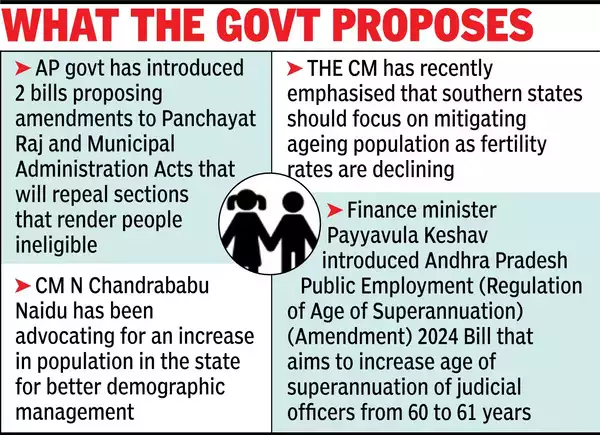- Courses
- GS Full Course 1 Year
- GS Full Course 2 Year
- GS Full Course 3 Year
- GS Full Course Till Selection
- CSAT
- 5 LAYERED ARJUNA Mentorship
- Public Administration Optional
- Online Program
- GS Recorded Course
- NCERT Batch
- Polity Module Course
- Geography Module Course
- Economy Module Course
- AMAC Module Course
- Modern India, Post Independence & World History Module Course
- Environment Module Course
- Governance Module Course
- Science & Tech. Module Course
- International Relations and Internal Security Module Course
- Disaster Management Module Course
- Ethics Module Course
- Essay Module Course
- Current Affairs Module Course
- ABOUT US
- OUR TOPPERS
- TEST SERIES
- FREE STUDY MATERIAL
- VIDEOS
- CONTACT US
Why Andhra Pradesh Scrapped the Two-Child Rule for Local Body Elections
Why Andhra Pradesh Scrapped the Two-Child Rule for Local Body Elections
25-11-2024

- In a significant move, Andhra Pradesh has decided to remove the long-standing two-child rule for contesting local body elections.
- The rule had been in place for nearly three decades, and its removal was announced by Chief Minister N Chandrababu Naidu on November 19, 2024.
1. Background: What Was the Two-Child Rule?
- The two-child rule restricted people with more than two children from standing for local body elections in Andhra Pradesh.
- The rule applied to elections at the panchayat (village), municipality, and other local levels.
- The rule was introduced in 1994 by the then Andhra Pradesh government (when the state was undivided) as part of efforts to control population growth.
- The policy had been a part of the Panchayat Raj Act and the Municipal Act.
2. Why Was the Two-Child Rule Introduced?
- The rule was introduced after it was found that the population control measures between the 1981 and 1991 censuses were not producing the expected results.
- At the time, India was struggling to manage its rapid population growth.
- In response to growing population concerns, the National Development Council (NDC) set up a committee in the early 1990s, chaired by Kerala CM K Karunakaran, which recommended that people with more than two children should be excluded from government positions.
- This recommendation was adopted by several states, including Andhra Pradesh.
3. Which States Adopted the Two-Child Rule?
- Rajasthan was the first state to adopt the rule for panchayat elections in 1992, followed by Andhra Pradesh, Haryana, and Odisha in 1994.
- Other states like Madhya Pradesh, Himachal Pradesh, Chhattisgarh, Maharashtra, Bihar, and Assam also adopted similar rules over the next two decades.
- Chhattisgarh, Haryana, Himachal Pradesh, and Madhya Pradesh rolled back the policy in 2005.
- A major reason for this was the declining sex ratio (fewer girls being born compared to boys), which many experts linked to the strict two-child policy.
- Technology for gender determination was widely used, which led to gender imbalances.
4. Why Did Andhra Pradesh Scrap the Two-Child Rule?
- N Chandrababu Naidu, the current Chief Minister of Andhra Pradesh, cited concerns over the ageing population of the state.
- He believes that a low fertility rate could eventually hurt the state’s economic productivity and workforce.
- State Minister K Parthasarathy pointed out that the state's Total Fertility Rate (TFR) had fallen to 1.5, which is lower than the national average of 2.11. A low TFR means fewer children are being born, which could lead to a shrinking younger population over time.
- The government has expressed concern that an ageing population with fewer young people would eventually affect the state's economic growth, as there would be fewer workers to drive development.
5. How Does This Connect to Delimitation?
- Delimitation refers to the process of re-drawing boundaries of constituencies based on population data.
- In India, the delimitation exercise is important for deciding the number of seats each state gets in Parliament and state legislatures.
- The delimitation exercise in 2026 is expected to be based on population data.
- Since southern states like Andhra Pradesh and Tamil Nadu have successfully implemented family planning measures, they have seen lower population growth rates compared to other states.
- Naidu and other southern leaders are concerned that the Centre might reduce their seats in Parliament because of their lower population.
- This has led to calls for a system that adjusts **seats based on economic performance, not just population.
6. Wider Political Support and Reactions
- Leaders from other states with similar concerns have expressed support for Naidu’s move.
- K T Rama Rao, working president of the Bharat Rashtra Samithi (BRS), criticized the idea of reducing seats for southern states based on population alone.
- He said that the economic performance of these states should also be taken into account.
- Tamil Nadu Chief Minister M K Stalin also expressed concern over the future of population-based political representation, emphasizing that the focus should be on prosperous families, not large families.
7. Challenges and Criticism of the Move
- While the Naidu government has called for incentives to encourage families to have more children, demographers warn that such incentives rarely work in reversing the trends of an ageing population.
- Many countries with similar policies, such as Japan and Italy, have seen limited success in increasing birth rates through financial or social incentives.
- Some people have argued that forcing people with more than two children out of elections was a violation of constitutional rights.
- There were several court challenges over the years against the policy, with people arguing that it was unfair to deny them the right to contest elections due to their family size.
What Does This Mean for the Future?
- By removing the two-child rule, Andhra Pradesh is signaling a shift in focus toward addressing the state's demographic challenges.
- With a declining birth rate and an ageing population, the government hopes to revitalize the state's workforce and maintain economic growth.
- While the move has been praised by some, it also raises broader concerns about how population policies affect representation and resource allocation in India.
- The issue of delimitation and political representation based on population is likely to be a key point of debate in the coming years.
- The long-term success of this move will depend on how well Andhra Pradesh can encourage families to have more children and balance its population growth with its economic needs.
- It remains to be seen whether these changes will have the desired effect on both the state's population and its political representation.
By scrapping the two-child policy, Andhra Pradesh is taking a significant step towards addressing its ageing population problem and rethinking the impact of population control measures on local governance and economic productivity.




